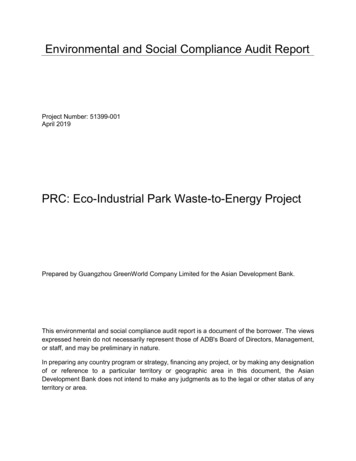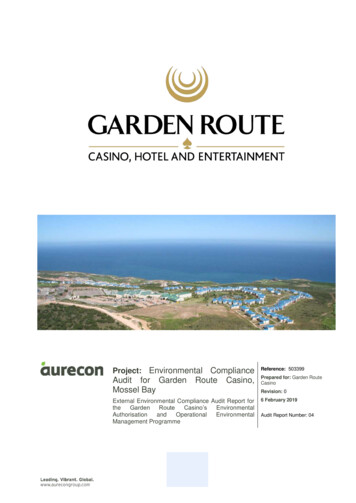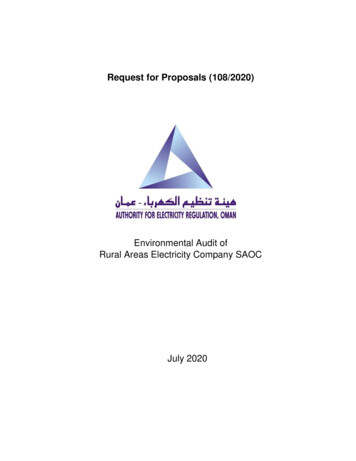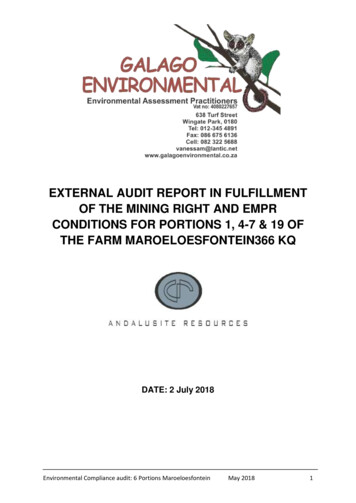
Transcription
Environmental and Social Compliance Audit ReportProject Number: 51399-001April 2019PRC: Eco-Industrial Park Waste-to-Energy ProjectPrepared by Guangzhou GreenWorld Company Limited for the Asian Development Bank.This environmental and social compliance audit report is a document of the borrower. The viewsexpressed herein do not necessarily represent those of ADB's Board of Directors, Management,or staff, and may be preliminary in nature.In preparing any country program or strategy, financing any project, or by making any designationof or reference to a particular territory or geographic area in this document, the AsianDevelopment Bank does not intend to make any judgments as to the legal or other status of anyterritory or area.
Environmental and Social Compliance Audit ReportPRC: Eco-Industrial Park Waste-to-Energy ProjectTaiyuan Waste-to Energy SubprojectApril 2019Shanghai SUS Environment Co., Ltd.Asian Development Bank
TABLE OF CONTENTEXECUTIVE SUMMARY . 11.INTRODUCTION. 61.1Background . 61.2Objectives. 61.3Methodology . 72.COMPLIANCE FRAMEWORK . 72.1ADB Safeguard Requirements. 82.2PRC Environmental Regulations . 92.3Evaluation Standards . 102.4PRC Health and Safety Regulations . 162.5PRC Land and Social Regulations . 173.DESCRIPTION OF THE PROJECT. 173.1Project Rationale . 173.2Project Area . 183.3Subproject Components . 233.4Associated/Linked Facilities . 253.5Subproject Progress . 274.ENVIRONMENTAL AUDITING FINDINGS. 274.1Compliance with applicable requirements of national laws and regulations, ADB SPSand international industry best practice standards. 274.2Audit of the Project Design . 284.3Audit of the Environmental Impact Assessment. 314.4Audit of the Environmental Management Plan . 434.5Compliance with national laws and regulations, SUS’ ESMS requirements, ADB SPSon information disclosure, consultation and participation (past, continuing and planned). . 48i.
4.6Corrective Action and/or Supplemental Studies. 505.SOCIAL AUDIT FINDINGS . 555.1Impacts of the Project. 555.2Policy framework and entitlement. 605.3Public Participation, Consultation and Information Disclosure . 655.4Grievance Redress Procedure. 655.5Agencies . 665.6Monitoring & Evaluation . 675.7Other Social Issues. 675.8Conclusions and Recommendations/Corrective Action Plans . 69Appendix 1 Safeguard Categorization Checklist . 71Appendix 2 Personnel met for the compliance auditing . 83Appendix 3Land and Social Related Laws and Regulations . 84Appendix 4 Domestic EIA Approval . 89APPENDIX 5 Ambient Environmental Quality Monitoring Results . 93Appendix 6 Air Quality Modelling Results . 100Appendix 7 Site-specific EMP . 117Appendix 8 Indicative Standard Operation Procedures for Operation . 118Appendix 9 Environmental Monitoring Plan . 119Appendix 10 GRM on Environment . 121Appendix 11Village 124Taiyuan EIP Phase I Land Acquisition Contract with DongnansheAppendix 12with TSABSUS Taiyuan Company Signed a 30-Years Free Use Land Agreement126Appendix 13Taiyuan WTE ProjectDecision on Allocation of State-Owned Construction Land for SUS127Appendix 14Public Consultation Records Submitted by Dongnanshe Village. 130ii.
iii.
EXECUTIVE SUMMARYShanghai SUS Environment Co., Ltd. (SUS) is proposing for ADB funding, a WTE project in theTaiyuan City, Shanxi Province, People’s Republic of China (PRC) (the WTE Project) as firstsubproject of the PRC: Eco-Industrial Park Waste-to-Energy Project.As part of its due diligence, ADB requires an environmental and social compliance due diligenceof the subproject (Taiyuan WTE) for ADB financing, including a review of key documents,including the Environmental Impact Assessment (EIA) report and an on-site assessment, toidentify past or present concerns related to risks and impacts on the environment, involuntaryresettlement and Indigenous Peoples during construction and operation. The objectives of theenvironmental and social compliance due diligence are to determine whether actions were andare in accordance with the requirements of ADB’s SPS, SUS’s enhanced ESMS, applicablenational laws and regulations and good international industry practices, identify if there areoutstanding compliance issues and prepare a corrective action plan, if needed.Construction of Taiyuan WTE plant was commenced in September 2017 and is expected to becomplete in March 2019. The commissioning is scheduled in June 2019. At the time of the onsite assessment, which was conducted on 11 to 12 December 2018, the construction progressis estimated at 70%.Key actions to be taken on environmental aspects are as follows:Key FindingsRecommended actions1. EIAThe key contents of EIA report weresummarized in section 4.3.It was reported by the Taiyuan SanitationAdministration Bureau (TSAB) staff that theEIA for the EIP planning is on-going.Planning EIA is a strategic EIA thatevaluates the environmental impacts of theEIP development and operation as awhole. The cumulative impacts reflected inthe EIP planning EIA shall be reported inthe annual environmental and socialperformance monitoring report of thesubproject as a supplementary study.The EIA report only considered thecumulative impact from the kitchen wastetreatment plant which is operating sinceNovember 2016 without consideration ofotherwastetreatmentfacilitiesfordevelopment or being developed within theEIP. It was noted that a sludge treatment plantand wastewater treatment plants are underconstruction at the time of site visit.Taiyuan WTE will quantify the direct andindirect GHG emission from its operationfollowing the methodology in Appendix 11of the SUS ESMS and will be included inthe annual environmental and socialperformance monitoring report. TaiyuanWTE is recommended to evaluatetechnically and financially feasible andcost-effective options to reduce or off-setproject-related GHG emissions during itsoperation.The EIA report did not include an assessmentof the Taiyuan WTE’s greenhouse gas (GHG)emissions.A separate EIA was prepared for thetransmissionline.TaiyuanSUSisconstructing the transmission line for the1
Key FindingsRecommended actionsShanxiProvincialPowerCompany.Construction is expected to be completed byJune 2019. The operation and maintenance ofthe transmission lines and towers will betransferredShanxiProvincialPowerCompany during operationTaiyuan SUS should strictly comply withthe mitigation measures in the approvedEIA. The compliance of the transmissionline construction with the identifiedmitigation measures in the EIA approvalshall be reported in the annualenvironmental and social performancemonitoring report of the subproject.2. EMP ImplementationThe environmental supervision company,who played an important role on EMPimplementation performance wasnotincluded in the EHS Committee.Include the environmental supervisioncompany in the EHS committee and addtheroleandresponsibilitiesofenvironmental supervision company in thesite EHS procedures to ensure theenvironmental supervision company canfully play its function.The EIP wastewater treatment plant (WWTP),where the Taiyuan WTE wastewater will betreatedduringoperation,maybecommissioned at least 2 months after theTaiyuanWTEcommissioning.Thisunforeseen delay was not considered in theEMP. As an interim measure, Taiyuan WTE,will transport its wastewater by truck to theEPB-designated until the EIP WWTE iscommissioned.3. MonitoringThe monitoring plan sets out in the EIR doesnot include monitoring program duringconstruction and does not include all indictorsas per 2010/75/EU.4. GRMThe project company operated an oralinformation disclosure and on.5. Information DisclosureThere are a few respondents concerningabout the health risk and pollution based onthe questionnaire survey results.Closely monitor the wastewater transportto the EPB-designated WWTP and includestatus in the first annual environmental andsocial performance report, including thetransportation method, securing thenecessary approvals and permits, theroutes taken, and grievances andcorresponding resolutions, if any.SUS will follow the monitoring plan inAppendix 9 and report to ADB in its annualperformance report.Establish a formal GRM system andmaintain the documentation as required inthe ESMS (Appendix 10).SUS shall develop a on disclosure during operation.2
Summary of key findings on social aspects could be summarized asLand acquisition and compensation – completed in 2016 with no identified legacy issues The SUS WTE project is located in Taiyuan Circular Economy Environmental SanitationIndustry Park (EIP), which is functionally designated in one area in Dongnanshe village. The total EIP planning area, where the proposed WTE plant is located, is 1,386 Mu (92.4hectare 1 ). To accelerate the land acquisition and compensation process, EIP landacquisition was undertaken by the government in two stages. The first stage (535 Mu,35.7 hectare) mainly acquired big parcels of communal waste land and the second phase(851 Mu, 56.7 hectare) will include acquire communal land and individual contractedland.2 At the time of this ESDD, the land acquisition for the second stage is not startedyet, and no detail information is available. The proposed WTE plant (8.3 hectare, 124.6Mu) is located within the communal waste land (first stage land acquisition area). A total of 8,3086 m2 (8.3 hectare) (124.6 Mu) land area was acquired for the SUS WTEproject, located in the EIP first stage land acquisition area. Land acquisition wascompleted in May 2016 following government led process. SUS WTE was granted theland use right for 30 years through free use land agreement. Construction activities forthe WTE subproject started in September 2017. The land acquired for the project was identified as communal waste land with official landcategory as flood land and water surface, prior to the land acquisition:–no villagers use the project area for agriculture or related economic activities;–there are no residential houses within the project site;–there are no existing structures; and–the project site is not used as access to obtain other income source, e.g. sandexcavation. Compensation for the land acquired was paid to the village collectively and the full amountwas received by village in May 2016. Of the total amount paid, 85% was equallydistributed to all villagers (approximately 2,000 USD per villager), while 15% of thecompensation was kept by village community for village development and villagers’welfare purposes. The actual compensation rate exceeded regulated compensation rateby 12%. Transmission Line. The electricity produced on site will be transmitted to the main gridwhich is part of the state grid plan of the government. Its construction is on going and willbe completed by June 2019. SUS provided funds in its construction but the design andimplementation were based on the plan and managed by the government through ShanxiPower Company. This is to ensure that the facility will be made available on time. Thecost will be reimbursed later by the government to SUS. The alignment indicated in Figure3.6 reflects that the WTE plant will be connected to the main grid through the 8 kmtransmission line. Based on the concession agreement, the government is responsible inensuring that a transmission line from the WTE plant is available to transmit the electricityto the main grid.11 hectare 15 muIn China, all land in rural area belongs to village communities unless expropriated. Normally, most of the cultivatecommunal land allocated/contracted to individual farmer households based on equivalent size and quality per headaccount, therefore each household may have land in several locations within the village.23
All documentation, records and primary information collected by the December visitconfirmed that there is no outstanding land acquisition and compensation related legacyissues as a result of land acquisition; all received information confirmed that there is nooutstanding compensation disbursement to villagers or related legacy issues. No issues related to gender were identified. It was known that the EIP location do nothave existing gender issue or concern, and audit didn’t reveal issues that related togender in the process of land acquisition, compensation and disbursement. SUS TaiyuanCompany have 64 full-time staffs, among them, 12 female staffs (19%) occupyingtechnical position. Meanwhile, among the 438 workers employed by the contractors atthe site during construction, 30 site workers (6.8%) are female; there are 10% (42 workers)of all workers undertake managerial work, 82% (360 workers) undertake technical work,while the rest 8% (36 workers) undertake non-technical work. Public consultation and information disclosure prior to land acquisition were regarded assufficient by villagers; all interviewed villagers reported their knowledge about the landacquisition, process, compensation rate and disbursement. The EIP is not located in an ethnic minority area, Dongnanshe village is not identified asan ethnic minority village nor there was any villager individual identified belonging to anyethnic minority group.Social impacts from construction nuisances The project is located in the EIP, within Dongnanshe village area, the closest villageresidential area is about 360 meters from the project site. Key measures to minimizeconstruction impacts have been developed by the project; measures include dustsuspension such as sprinkling the road and covering dirt grounds. Other constructionnuisances (such as noise, vibration) are not expected to impact the local communitybased on longer distance to the village. Grievance mechanism for this project follows the existing social structure. Any grievancefrom villagers either goes to the village office or grievances can reach the project companyfirst and will then be escalated to government agencies following the ladder of village,town and city. Interviewed SUS Company and TSAB representatives all expressed thatthere are no known grievances related to the land acquisition, compensation nor to theconstruction that is significant. As a good practice, SUS WTE prioritized job opportunities to villagers for positions suchas security and operation workers. SUS Taiyuan Company have 64 full-time staffs,among them, 3 technicians come from affected Dongnanshe village. SUS Taiyuan WTECompany hired two service companies, 61% of onsite staffs (13 workers) come fromaffected Dongnanshe village. Meanwhile, about 7% of the entire workforce in theconstruction team comes from Dongnanshe village.Public health and safety (at construction and operation stage) - Stakeholder engagement There has been growing concerns from the general public regarding WTE projects, suchas pollution and its control, public consultations were conducted during the preparation ofdomestic EIA. However, there are no specific requirements by the government for theWTE project during construction stage and engagements are therefore mainly with localaffected community regarding the land acquisition and compensation. Periodicstakeholder engagement and information disclosure (including both social andenvironmental impacts, mitigation measures) is therefore recommended to be developedto address key concerns from the general public and provide material and meaningful4
information to local community. Key social impacts associated with operation are transportation corridor (traffic and odorcontrol), and air emission (in particular, odor control and hazard air emission). Thoseissues have been identified in the EIA with specific management measures to minimizethe impacts. SUS Taiyuan WTE Company should work with local government, such asTSAB, and village committee to present relevant information to the communities duringstakeholder engagement activities with local communities’ understandable manners. Transportation – modern closed transportation truck will be used to transport municipalwaste to minimize the odor. Transportation will not use any village road nor run throughvillages.5
1.INTRODUCTION1.1 BackgroundShanghai SUS Environment Co., Ltd. (SUS), majority owned by CITIC Private Equity, is anintegrated environmental protection solution provider. Its operations are mainly focused on fivesectors: Eco-Industrial Park-investment, operation and maintenance of municipal solid waste-toenergy (WTE) plant, the facilities for sludge, medical waste, kitchen waste and constructionand electronic waste, etc.Waste-to-Energy EPC-SUS started with introduction of grate type incineration technologyfrom Hitachi Zosen Corporation. SUS supplies waste incinerator equipment and EPCservices to Waste-to-Energy developers;Soil Remediation-environmental services for land remediation and re-development; andBiomass utilization of agricultural and forestry waste.SUS has signed a concession agreement on MSW treatment with Taiyuan Municipal SanitationAdministration Bureau in January 2017. During the concession period, Taiyuan MunicipalSanitation Administration Bureau (TSAB) guarantees no less than 1,000,000 t/a (equals to 3,000t/d) municipal solid waste. SUS Taiyuan Waste to Energy Co., Ltd, the project company, isdeveloping the 80-megawatt (MW) Taiyuan Waste-to-Energy Power Project (the subproject),located inside the Taiyuan Circular Economy and Sanitation Industry Demonstration Park (theEIP), Dongnanshe Village, Qingxu County, Taiyuan City, Shanxi Province of People’s Republicof China (PRC). During the concession period SUS Taiyuan WTE power plant will provide powerto the grid and steam to the sludge and kitchen waste treatment facilities in the EIP.SUS has requested corporate financing from Asian Development Bank (ADB) and is planning toinclude the Taiyuan WTE power plant in the portfolio of WTE plants to be financed by ADB. Theproject is categorized as B for environment and C for involuntary resettlement and IndigenousPeoples based on SUS’ ESMS (Appendix 1). SUS enhanced its ESMS to comply with therequirements of ADB’s Safeguard Policy Statement (2009) (SPS).In order to meet the requirements of SUS’ enhanced ESMS, a stand-alone audit of environmentaland social compliance was conducted to identify past or present concerns related to risks andimpacts on the environment, involuntary resettlement and Indigenous Peoples.1.2 ObjectivesThe objectives of this environmental and social compliance due diligence are to: Determine whether actions and activities during the pre-construction, construction andoperation phases were and are in compliance with the requirements of SPS, and SUS’senhanced ESMS, applicable national laws and regulations and good international industrypractices; andPropose a corrective action plan (CAP) that sets out the actions that the subproject needs toimplement and/or supplemental studies to be conducted in order to achieve compliance withthe requirements of SPS, SUS’s enhanced ESMS, applicable national laws and regulationsand good international industry practices.6
1.3 MethodologyThe methodologies adopted for the environmental and social due diligence included the followingactivities: (i) desk review and discussion with SUS manager on SUS existing EnvironmentalHealth and Safety System (EHSS); (ii) a review of relevant national laws, regulations andguidelines related to environmental, social impact assessment, land acquisition andcompensation, ethnic minorities, public consultation and participation; (iii) interviews with the SUSWTE management and construction managers, EHS staff from contractor, constructionsupervision company, environmental supervision company, solid waste transfer station, TaiyuanMunicipal Environmental Protection Bureau (EPB), representatives from villages nearby andMunicipal Sanitation Administration Bureau (TSAB); and (iv) site inspection. The documentaryreview and interviews were carried out during the course of the site visit with an aim of assessingthe on-site environmental management, labor and working conditions, land acquisition adcompensation, indigenous peoples, as well as gender and development aspect of SUS TaiyuanWTE. A site visit to the subproject area was conducted in 10 to 12 December 2018. The deskbased review of project documentation included the following key documents: Project Environmental Impact Assessment (EIA) report, July 2017;Project Feasibility Study Report (FSR), July 2017;Project Preliminary Design (text part); April 2018;Soil and Water Conservation Plan, August 2017;Cultural Relics Investigation Survey, December 2016;Flood Risk Assessment, October 2016;Earthquake Risk Assessment, October 2016;Opinions on Connection to Grid, July 2016;Modification of Taiyuan EIP Detailed Plan, June 2018;Draft PPP Concession Agreement (table of content and environmental and social relatedpages), January 2017;Wastewater treatment agreement, March 2017;Tentative fly ash disposal agreement, January 2017;SUS Taiyuan EHS Procedures for Construction, January 2018;Safety Pre-Assessment, February 2017;Occupational health risk assessment, April 2017;Land acquisition contract with Dongnanshe village;Land free use contract with the TSAB.A list of personnel interviewed is provided Appendix 2.2.COMPLIANCE FRAMEWORKADB’s SPS requires an environmental and/or social compliance audit, including on-siteassessment, for projects or subprojects involving facilities that already exist or are underconstruction to identify past or present concerns related to impacts on the environment,involuntary resettlement, and Indigenous Peoples. The audit includes an evaluation of thesubproject’s compliance with the following applicable environmental and social requirements:7
2.1 ADB Safeguard Requirements ADB’s Safeguard Policy Statement, 20093. The ADB’s SPS sets out the policy objectivesscope and trigger, and principles for following three key safeguard areas: (i) environmentalsafeguard; (ii) involuntary resettlement safeguard; and (iii) indigenous peoples safeguard.The objective and scope of above these key areas are briefly described below. Safeguards Requirement 1 (SR1) on Environment. SR1 ensures the environmentalsoundness and sustainability of subprojects and supports the integration ofenvironmental considerations into the subproject decision-making process.Environmental safeguards are triggered if a subproject is likely to have potentialenvironmental risks and impacts. During the design, construction, and operation of asubproject, SUS will apply technologies and practices consistent with international goodpractice, as reflected in internationally recognized standards such as the WB’s EHSGuidelines and IED 2010/75/EU. Safeguards Requirement 2 (SR2) on Involuntary Resettlement. SR2 requiresavoidance or minimization of involuntary resettlement by exploring subproject designalternatives; to enhance, or at least restore, the livelihoods of all displaced person(s) inreal terms relative to pre-project levels; and to improve the standards of living of thedisplaced poor and other vulnerable groups. The involuntary resettlement safeguardscover physical displacement (relocation loss of residential land or loss of shelter) andeconomic displacement (loss of land assets, access to assets, income sources, or meansof livelihoods) because of involuntary restrictions on land use or on access to legallydesignated parks and protected areas. It covers them whether such losses andinvoluntary restrictions are full or partial, permanent or temporary.Safeguards Requirement 3 (SR3) on Indigenous Peoples. SR3 requires the designand implementation of subprojects in a way that fosters full respect for indigenouspeoples’ identity, dignity, human rights, livelihood systems, and cultural uniqueness asdefined by the indigenous peoples themselves so that they: (i) receive culturallyappropriate social and economic benefits, (ii) do not suffer adverse impacts because ofsubprojects, and (iii) can participate actively in subprojects that affect them. SR3 istriggered if a subproject directly or indirectly affects the dignity, human rights, livelihoodsystems or culture of indigenous peoples or affects the territories or natural or culturalresources that indigenous peoples own, use, occupy, or claim as an ancestral domain orasset.ADB’s Policy on Gender and Development (GAD) (1998)4. ADB’s policy on GAD includedmainstreaming as a key strategy in promoting gender equity. With respect to subprojects, theGAD policy requires: gender analysis: to assess systematically the impact of a subproject on men and women,and on the economic and social relationship between themgender planning: to formulate specific strategies that aim to bring about equalopportunities for men and cy-statement4 velopment8
mainstreaming: to consider gender issues in all aspects of corporate’s operations,accompanied by efforts to encourage women’s participation in the decision-makingprocess in development activities ADB’s Social Protection Strategy (2001) 5 . ADB’s Social Protection Strategy (2001)requires the company, its contractors and subcontractors to comply with applicable labor lawsin relation to the subproject and take measures to comply with the core labor standards. Corelabor standards include a set of four internationally recognized basic rights and principles atwork: (i) freedom of association and the effective recognition of the right to collectivebargaining; (ii) elimination of all forms of forced or compulsory labor; (iii) effective abolition ofchild labor; and (iv) elimination of discrimination in respect of employment and occupation.SUS, its contractors and subcontractors will also endeavor to employ local labor wheneverpossible and take measures to comply with ADB’s Social Protection Requirements. ADB’s Access to Information Policy (2019)6. The objective of the Access to InformationPolicy is to promote stakeholder trust in ADB and to increase the development impact of ADBactivities. It requires transparency, accountability, an
Environmental and Social Compliance Audit Report Project Number: 51399-001 April 2019 PRC: Eco-Industrial Park Waste-to-Energy Project Prepared by Guangzhou GreenWorld Company Limited for the Asian Development Bank. This environmental and social compliance audit report is a document of the borrower. The views










